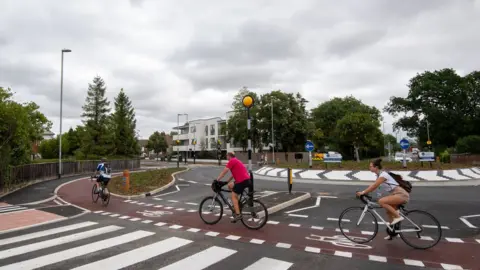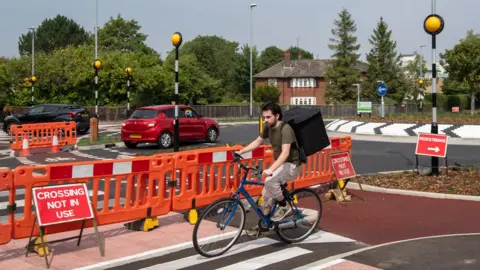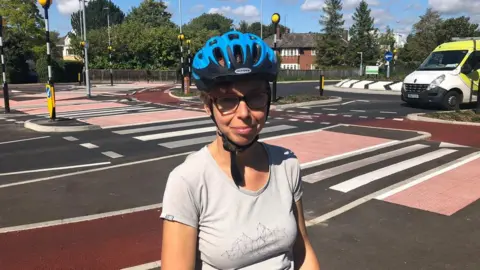Cambridge's Dutch-style roundabout: Why all the fuss?
 PA Media
PA MediaThe construction of a new roundabout does not often make national headlines, but one in Cambridge that gives priority to pedestrians and cyclists has done just that. So why all the fuss?
The Fendon Road roundabout is the UK's first and so-far-only so-called "Dutch-style" roundabout.
Situated near Addenbrooke's and Papworth hospitals, it was built by the county council in an attempt to improve the safety of its predecessor, which had seen 12 collisions between cars and cyclists between 2012 and 2017.
But within a few days of its opening in July, it had to close temporarily after a hit-and-run driver crashed into a zebra crossing beacon.
In the national press, it was dubbed a "£2.3m 'cyclist killing zone'", while one columnist argued it would "only intensify the war between cyclists and drivers".
Driving on the roundabout
Mark Lawrence-Jones's heartbeat rises as he approaches the roundabout in his car.
First there is a pedestrian crossing to negotiate. "You've got to look right for the cyclist, then you're on to the roundabout, then you're looking right for the cars," he said.
"Then, when you leave the roundabout, you've got to be looking over your left shoulder for any cyclists, and then you've got to quickly whirl around to your right to see if anybody is going to come across the pedestrian crossing.
"As I exit the roundabout I feel dizzy because I've been moving my head hard to the left and hard to the right to look out for people. It's very difficult at the same time to actually look where you're going."
 Mark Lawrence-Jones
Mark Lawrence-JonesMr Lawrence-Jones, who lives nearby, said he knew people, including his 13-year-old daughter, who would no longer use the roundabout.
"It's clear that a lot of people have reservations about the roundabout, and if the idea was to make a piece of infrastructure which people feel safe on I don't know if that's been achieved," he said.
There were accidents on the old roundabout, he acknowledged, but said: "The big question is 'Is whatever you're putting in safer than that?'
"No evidence has been put out for that, despite us asking for it repeatedly for three or four years. That's what's so frustrating."
 Joe Giddens/PA Media
Joe Giddens/PA MediaHowever, the RAC's head of roads policy, Nicholas Lyes, believes the council "should take credit for trying to improve safety for all road users".
"For drivers, this may well be an unusual junction to navigate in the first instance, but they should remember that priority must be given to both cyclists and pedestrians, as well as the usual 'give way' to vehicles approaching from the right," he said.
"Some might have concerns about the impact on congestion but ultimately, if the scheme reduces collisions and injuries, then that will be the true measure of success."
The cyclists
The largely flat university city of Cambridge is famed for its high number of cyclists, and Roxanne de Beaux, executive director of local cycling group Camcycle, said that in the past six months two had died on its roundabouts.
 Camcycle
CamcycleShe acknowledged the Fendon Road roundabout was receiving a lot of scrutiny and that much could be learned for future roundabout designs.
But she added: "We must not forget to continue to scrutinise dangerous, typical, British-style roundabout designs, which are proven to be deadly and unpleasant for all road users."
The most common feedback from cyclists and drivers was "This is better than expected," she said.
"Many have noted the improved geometry that allows people cycling and driving to better see each other and react accordingly."
You might also like:
The roundabout opened just a few days after the government announced a scheme offering £50 bike repair vouchers as part of plans to boost cycling and walking.
Ms de Beaux said the new roundabout "has shown the standard of cycling infrastructure we should now be expecting nationwide".

At the roundabout itself, one cyclist, who did not want to be named, felt a driver was unaware she had to stop for cyclists "until I looked at her and made her stop".
The cyclist said: "I can see it would be very easy for someone to get knocked over. I think the design of the roundabout is not very clear as you approach it at all.
"You only know the changes when you're on it, and then you're looking at the road and you might not necessarily know what's coming."
The council view
After consulting in the Netherlands, Cambridgeshire County Council drew up plans and construction of the roundabout began in September 2019.
But by its opening, the project's cost had risen from an estimated £800,000 to £2.3m.
That led local group Smarter Cambridge Transport to accuse the authority of "recklessly pushing ahead" with the project.
The council blamed the escalating cost on unexpected utility works and Covid-19, while others pointed out that before construction even began, it had risen to £1.5m.
 PA Media
PA MediaIan Bates, chairman of the council's highways and transport committee, said he had discussed safety concerns with residents personally and would be happy to share documentation with them.
"No roundabout can 100% have no accident ever - I think that's almost an impossible task," he said.
"But the evidence we got from the work which was being done in the Netherlands all indicated that... the Dutch-style roundabout assisted cyclists and brought attention to drivers of cyclists in general."
Mr Bates said he recognised the new roundabout "hasn't been easy for everybody, because of the unfamiliarity that the cyclist has the priority".
But, despite local reservations over safety, the council said there had been no reported accidents or incidents on the roundabout since it officially opened on 31 July.
Mr Bates admitted the authority needed to learn some lessons, including getting a costing earlier in the process and doing more work with utilities companies before digging up the road.
However, he added: "It's always difficult to be the first. I have no regrets for being the first in England.
"It's sometimes better to be second or third, mind you, but that's not the way of Cambridge or Cambridgeshire."
Where next?
Planners up and down the country are keeping a keen eye on the roundabout, and other areas have already shown an interest in replicating it.
One has been mooted for Braintree, Essex, as part of a network of sustainable cycle routes.
In Hertfordshire, there are plans afoot for a Dutch-style roundabout in Hemel Hempstead, as part of an ongoing project "to deliver an attractive and safe cycling route along a north-south corridor through a key business park".
 Google
GoogleA Hertfordshire County Council spokeswoman said: "The junction is currently used by high volumes of heavy goods vehicles and is difficult for pedestrians and cyclists to cross."
She said the proposed roundabout would fully segregate pedestrians and cyclists from vehicles and "make it a much safer junction for them to negotiate".
The council said it was "aware that such layouts are unfamiliar to British drivers", but believed there could be more to come in the county in the future where there were junctions that were "difficult for pedestrians and cyclists to negotiate on our cycle networks".

Find BBC News: East of England on Facebook, Instagram and Twitter. If you have a story suggestion email [email protected]
